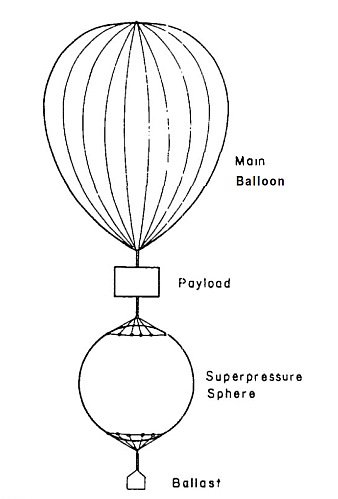Purpose of the flight and payload description
The Sky Anchor System was a two balloon system developed and tested by the National Scientific Balloon Facility (NSBF), during the 70's and 80's decade as part of a long lasting effort of the agency to develope a long duration balloon system. The concept -originally tested in a small scale in 1963- was boosted by the needs of the scientific ballooning community which could benefit in many areas of interest from longer exposure times at altitude. The final goal of the developmental effort was to built a vehicle capable of transport a 500 lb scientific payload at 130,000 ft for a minimum of 100 days duration.
The Sky Anchor system used a two balloon system on which a conventional zero pressure balloon (open) carried below a super pressure balloon (closed) which acted as ballast and anchor. In the image at left is a basic scheme of the system (a more detailed description can be seen clicking over the drawing).
The theoretical operation of the system was as follows. Once the system was airborne, on the way to the main balloon's operational altitude, the super pressure became filled and pressurized. As the "super pressure" continued to be carried upward it losed more and more lift. When sunset occured the entire system descended to a new equilibrium altitude where the increase in lift on the super pressure balloon just equaled the sunset effect on the main balloon. Although its volume was decreased, no gas was lost from the main balloon. At sunrise, the main balloon expanded and the system once again rose. In so doing the super pressure balloon losed the lift that it gained at sunset and the system stabilized at the same altitude as the preceding day. Since there was no change in suspended weight on the main balloon, it should not overshoot and again there will be no loss of gas. As in the pure super pressure system, assuming there were no leaks, the flight duration was limited only by creep, gas diffusion and ultraviolet degradation of the balloon fabric.
Throughout the development of the program, the actual flight experience turned out to be much more complex than planned, so after mixed results on 14 flights over six years, the program was abandoned in 1982. However, the experience gained would pave the way for other groups to develop more successful designs in the future. This would allow the original goal behind Sky Anchor to be achieved in the early decades of the 21st century.
Details of the balloon flight
Balloon launched on: 10/26/1977
Launch site: Columbia Scientific Balloon Facility, Palestine, Texas, US
Balloon launched by: National Scientific Balloon Facility (NSBF)
Balloon manufacturer/size/composition: Zero Pressure Balloon Winzen 116.997 m3 (12.70 microns - Stratofilm) - Raven 35.438 (38 microns Celanar)
Flight identification number: 1046PT
End of flight (L for landing time, W for last contact, otherwise termination time): 10/26/1977
Payload weight: 234 kgs.
This was the fifth test flight of the system. Sky Anchor V mission was launched from the National Scientific Balloon Facility in Palestine, Texas on October 26, 1977. The balloon system consisted of a 4.130.000 cubic feet zero pressure balloon, a 516 lb payload and a 1.250.000 cubic feet super pressure balloon. Instrumentation included altitude monitoring, two super 8 mm movie cameras, a differential pressure gauge, air temperature monitoring, and video camera for real-time visual monitoring of the system.
The launch of the system went very smoothly. Shortly after launch the balloon system slowed due to an inversion, but after breaking through it started ascending at the planned 500 feet/second. At approximately 19,000 feet it was noticed that the super pressure balloon was being destroyed. Shortly after this the system failed and the flight was terminated.
After reviewing the video tapes and down camera film it became obvious that the balloon destruct had prematurely activated itself. The electronics were then inspected and it was found that damage had occurred to the terminate electronics and the main electronics package above. After reviewing a large number of possible causes it was concluded that a static discharge was the only cause that could generate enough voltage to cause the damage that had occurred. Steps have since been taken to help try to eliminate the problem by electrically isolating the destruct electronics from any other electronics.
External references
- Advances in long duration, high altitude flights Advances in Space Research, Volume 1, Issue 11, 1981, Pag. 193
- Development of the Sky Anchor Balloon System AFGL-TR-79-0053, Special Reports No. 217, 1978
- National Scientific Balloon Facility Annual Report FY 1978 National Center for Atmospheric Research, January 1979
5591If you consider this website interesting or useful, you can help me to keep it up and running with a small donation to cover the operational costs. Just the equivalent of the price of a cup of coffee helps a lot.


